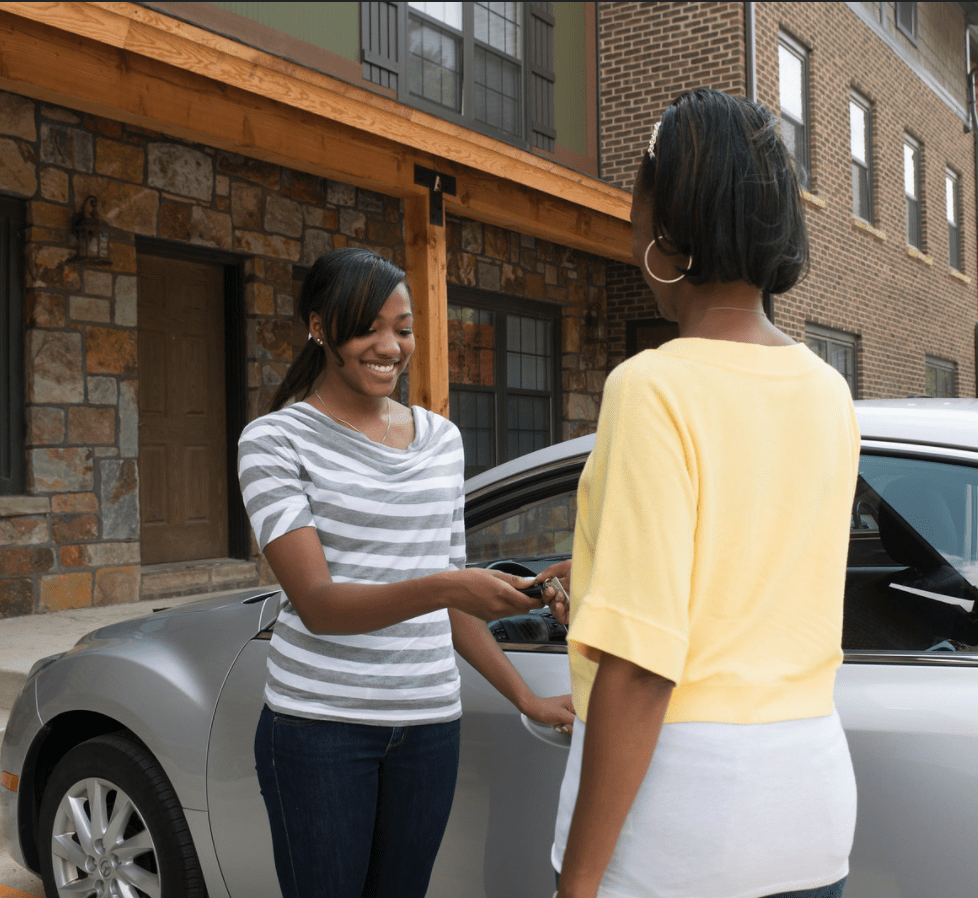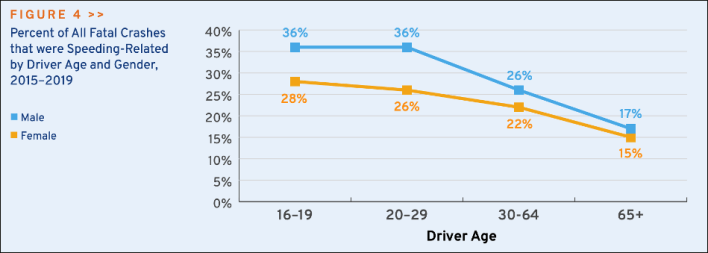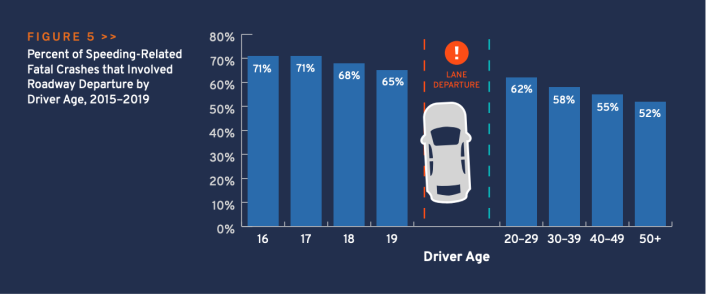Why America Can’t Rein in Teen Speeding
12:01 AM EST on February 1, 2021

Source: Creative Commons.
They're rebels who need to be paused.
The per-mile crash rate for teenage drivers is a whopping four times higher than drivers over 20, according to a new study that mostly blames teen speeding. But some advocates think addressing the problem will take far more than the enforcement and education-based solutions outlined in the report — and must include giving young people mobility options besides climbing behind the wheel.
In a new report financed by the Ford Motor Company Fund — the automaker has been attempting to rebrand itself as a safety and mobility outfit in recent years, to a mixed response from advocates — analysts at the Governors Highway Safety Association found that a whopping 43 percent of teenage drivers who killed someone in a car crash in the last four years were speeding, compared to 30 percent of adult drivers.
Teens were also found to be the demographic group that was most likely to kill a pedestrian or cyclist.

Should teens drive at all?
The news that literal children are the least qualified candidates to pilot two-ton automobiles is not exactly groundbreaking. But the role that speeding, specifically, plays in increasing the death toll among the youngest drivers has been relatively understudied — and like every aspect of our speeding epidemic, solutions to the problem have been uniquely hard to win.
Like drivers of all ages, countless young motorists across the country are driving on roads that were systematically designed to prioritize vehicle speed above road user safety — designs that can actually induce drivers of all ages to hit the gas, even when speed limits are set at safe levels (which, to be clear, they're often not.) And that's just the physical manifestation of what the GHSA calls America's "culture of speeding in which many drivers view speed limits as minimums rather than the maximums based on ideal conditions." (Some might say the funders of this report are among the chief contributors to that culture.)
Combine those daunting systemic problems with the perils of inexperience and the immaturity of the average 11th grader — the report itself notes that the regions of the brain associated with "impulse control, decision making and judgement" aren't fully developed until the early- to mid-twenties — and some advocates argue that there's simply no such thing as a "safe" child driver, whether they're speeding or not.
Most countries around the world seem to agree: the vast majority of nations in Europe, Asia and Africa set their minimum driving ages at 18, with limited supervised driving at the age of 17.
Many U.S. states, meanwhile, allow children to drive with supervision as early as age 15-1/2. Children in South Dakota famously can obtain a restricted license at age 14-1/4 that allows them to drive without supervision, albeit only before 10 p.m. and after 6 a.m.

Unsurprisingly, one of the major policy recommendations in the Association's report are aimed at keeping teens out of the driver's seat for as long as possible — or at least keeping a parent or caregiver in the passenger's seat to supervise them.
The National Highway Traffic Safety Association has advocated for common-sense driver's licensing measures such as restricting teens from driving after dark, or from transporting passengers who might distract them from the road. Such measures can cut the risk of crashes by as much a 50 percent, though that still wouldn't be enough to make a teen as safe as an adult driver. But the Association says it would be a good start — and a more achievable goal in car-obsessed states.
"Right now, we don’t see many states changing licensing ages anytime soon," said Pam Shadel Fischer, senior director of external engagement for the GHSA. "Though my state, New Jersey, has the oldest licensing age in NJ; 17. Would I encourage other states to look at it? Absolutely."
Speed reform without infrastructure reform?
But the Association itself stopped short of urging its member states to raise their licensing ages — and it didn't offer many other policy-based solutions to the problem of teen speeding, either.
Aside from a brief mention of automated speed enforcement at traffic lights, most of the Association's recommendations are devoted to individual and family-level strategies to curb dangerous driving, like purchasing smartphone apps to remotely monitor the teens behind the wheel, and adopting "parent-teen driver agreements" that re-iterate the rules of the road.
Driver's education is briefly mentioned — Ford's own online "driving academy," of course, gets a shout out — but the report itself concedes that there is only "mixed evidence" regarding its effectiveness. The Insurance Institute for Highway Safety notes that "formal evaluations of U.S. high school driver education programs indicate little or no reduction in crashes per licensed driver" on its own fact sheet on the problem, citing five separate peer-reviewed studies.
But Fischer does point out that at least one recent study of teen drivers in Nebraska showed that driver's ed, when deployed with a good graduated driver's licensing program, was successful at reducing collisions. And she also notes that given the political realities of car-obsessed America, harm reduction tools shouldn't be dismissed.
"We’re the behavioral safety folks. We don’t build the roads," said Fischer. "We’re absolutely supportive of infrastructure related solutions; it’s just not our area of focus. We're focused on what states can do — and what states can encourage their families to do — to increase roadway safety."
How to stop a teen speeder: put her on the bus?
Some advocates, of course, might point out that teen speeding, like all speeding, is a problem that probably can't solved without the tools of good road design. And those designs must include infrastructure like sidewalks, bus stops, and other investments that encourage teens to get out of the car completely.
Even without those investments, it may already be happening. Teen licensing rates have been declining drastically since the 1980s, even as licensing ages have largely remained unchanged; researchers speculate that the states that have already adopted graduated licensing requirements have a lot to do with the decline, as well as the ballooning costs of automobile ownership. One survey showed that 22 percent of teens without licenses simply “prefer to bike or walk.”

Those trends have lead some advocates to wonder what would happen if the U.S. stopped focusing so much on getting teen drivers to slow down, and started investing in the safety and mobility of young people beyond the family car — an approach which would save even more lives.
"[The GHSA] is focused on drivers, so the trends that they see and they’re responding to are of concern to those who are driving," said Kari Schlosshauer, policy manager for the Safe Routes Partnership. "But in our work, we’re looking at how we can provide options for families by promoting safe infrastructure — because we can't expect every teen to be able to, or want, to drive."
The Partnership's federally funded flagship program, Safe Routes to School, has historically been targeted at students in eighth grade and younger, but it's currently seeking congressional sponsors for an expansion act that would make high schools eligible as well. Schlosshauer is optimistic that such a program could lay the groundwork for a more foundational conversation about expanding the mobility of young Americans — including the unique needs of teenagers.
"Our work isn't just about how to get a little kid to her classroom, but how to get all kids to, say, after-school sports, or an after-school job, or to community service — all those things teenagers, especially, are doing that the yellow bus doesn’t connect them with," Schlosshauer adds. "How do you create a safe route to a transit stop? How do you teach a teenager to feel confident riding the [city] bus? I don’t want to discount the fact that [teen speeding] statistics are real. But we want to open up the conversation and make sure that what we’re talking about how families of all income groups get where they need to go."
Kea Wilson has more than a dozen years experience as a writer telling emotional, urgent and actionable stories that motivate average Americans to get involved in making their cities better places. She is also a novelist, cyclist, and affordable housing advocate. She previously worked at Strong Towns, and currently lives in St. Louis, MO. Kea can be reached at kea@streetsblog.org or on Twitter @streetsblogkea. Please reach out to her with tips and submissions.
Read More:
Stay in touch
Sign up for our free newsletter
More from Streetsblog USA
Talking Headways Podcast: Money is a Lot of Different Things
It's Part II of our discussion with Jim Kumon!
If Thursday’s Headlines Build It, They Will Come
Why can the U.S. quickly rebuild a bridge for cars, but not do the same for transit? It comes down to political will and a reliance on consultants.
Wider Highways Don’t Solve Congestion. So Why Are We Still Knocking Down Homes for Them?
Highway expansion projects certainly qualify as projects for public use. But do they deliver a public benefit that justifies taking private property?
Kiss Wednesday’s Headlines on the Bus
Bus-only lanes result in faster service that saves transit agencies money and helps riders get to work faster.
Freeway Drivers Keep Slamming into Bridge Railing in L.A.’s Griffith Park
Drivers keep smashing the Riverside Drive Bridge railing - plus a few other Griffith Park bike/walk updates.




